ART REVIEW: Imagining the end of the city, ‘After Cities’ at Fjord Gallery
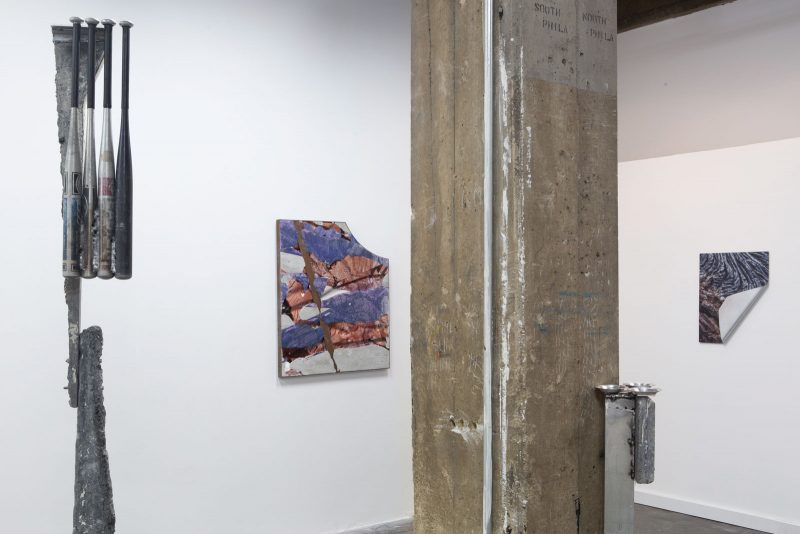 |
| Exhibition view: “After Cities”, works by Letha Wilson and Jeff Williams at Fjord Gallery. |
I’ve never not seen myself living in a city, and I find myself gravitating towards their energy no matter what state or country I’m in. I love walking the streets, admiring the crush of people and mishmash of architecture, hearing snippets of conversations in dozens of languages–being a part of a vital whole. So Jeff Williams’ and Letha Wilson’s two-person show at FJORD, After Cities, forces me to consider a sobering reality: what does the end of the city look like? And what does it mean for the future of humanity?
In the two-person exhibit, one artist, Jeff Williams, focuses on the materials and objects that are left behind after disaster, after the end of the world, after the end of cities. The second participating artist, Letha Wilson, focuses on the marks made on the landscape by human intervention.
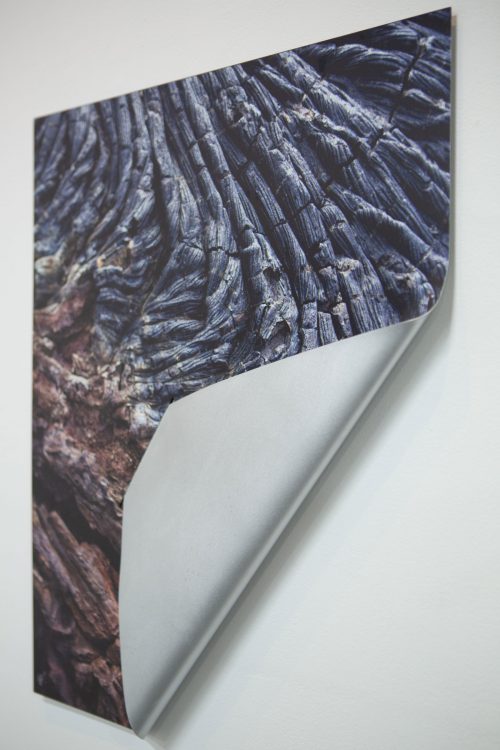 |
| Letha Wilson, Volcano Aluminum Bend, 2019, UV print on Aluminum, 24 x 20 x 1.5 inches. From “After Cities” at Fjord Gallery. |
In Williams’ work, the question is: what objects are the cockroaches of human civilization, destined to last long after their meanings have been divorced from their forms? The answer is aluminum-made objects, shining in their quotidian uses. In “Welded Bundt,” a melted Bundt cake pan fused to a dish hangs on a wall in the gallery space, looking oddly like part of a suit of armor. In “Pins,” a pile of sleek, shiny rolling pins rests on the ground, fused together to the point of uselessness. In “Dig Up the Earth (decorate its surface),” what appears to have been a section of a fence is removed from its context, instead left to hang askew, attached to a tall, thin slab of concrete and adorned by partially-melted aluminum mugs and measuring scoops. “Dig Up the Earth” comes across as deeply ironic, because what is the purpose of a fence when everyone is gone? Williams’s work suggests that the evidence that people lived and worked here remains embedded in the histories of these objects, even if these objects cannot tell us much about what these people were like.
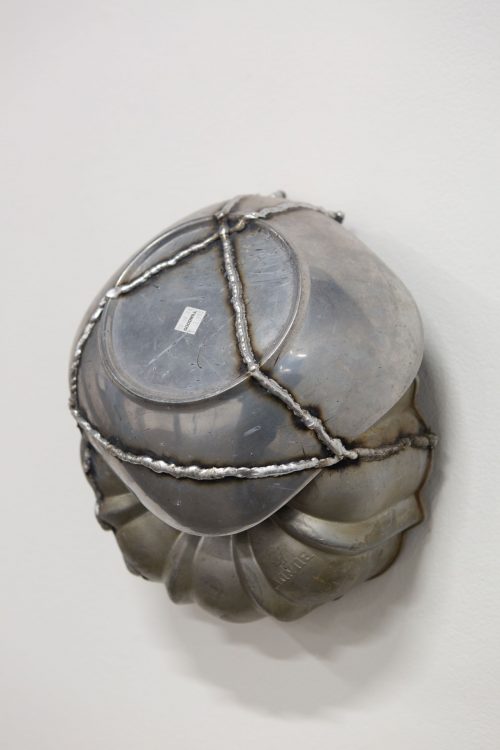 |
| Jeff Williams, Welded Bundt, 2018, welded aluminum thrift, 12 x 14 x 4 inches. From “After Cities” at Fjord Gallery. |
Williams’ aluminum objects survive without purpose, sure to confound the inevitable aliens that come to Earth to learn about what humanity was. The aluminum objects hint to the nature of the humans who owned them, but why these objects survived has more to do with the 200-500 year lifespan of the material they are made of than whether they were significant sentimental objects preserved by intent. Meanwhile, do the baseball bats hanging from the metal-concrete apparatus of “Slag Stalagmite Colony” signify violence or play, or maybe both?
While the title and arrangement of “Slag Stalagmite Colony” allude to a natural phenomenon of minerals grown in caves, Letha Wilson’s photographic installations call direct attention to the irreversible scars humans left on the surface of the world. Though it’s a far cry from the beautiful (unreal) vision of a green-friendly city, Wilson’s photographic images imagine beauty, albeit preserved in an extreme, often disturbing way.
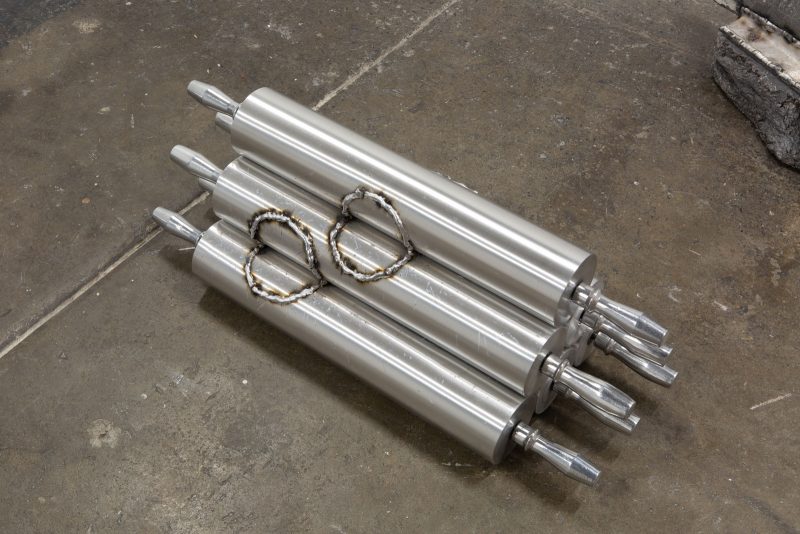 |
| Jeff Williams, Pins, 2019, welded aluminum restaurant supply, 28 x 9 x 9 inches. From “After Cities” at Fjord gallery. |
“Zion Shadows Glass Pinch” consists of a large-scale photograph of a beautiful hillside with sculptural add-ons. The photo is placed partially under glass, mounted on a wall, and distorted in the middle, pinched and rounded out by a metallic tube placed behind it. The work uses the uncanny element of exaggerated image disruption to suggest the distortion we’ve done to our landscapes in an unexpected and literal way.
People like to imagine that when humans are gone, the earth will heal itself, mend itself back together, but that optimism discounts the power of how much human impact there’s been. This false hope is alluded to in Wilson’s works. “Zion Shadows Glass Pinch” shows a vision of a landscape, distorted by metal and glass, that will never heal properly. “Steel Face Concrete Bend” comprises images of rock layered with the human-made materials metal and concrete, creating an almost sedimentary feel as the three components seem to collapse together.
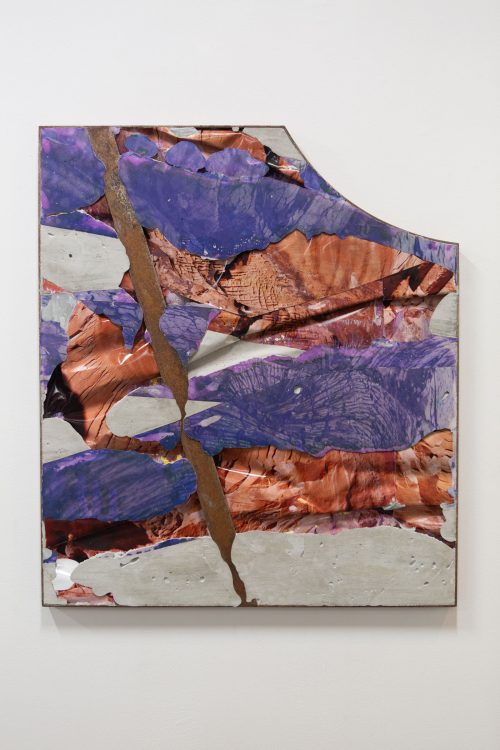 |
| Letha Wilson, Steel Face Concrete Bend (Valley of Fire Kilauea) 2018, Unique C-Prints, concrete, emulsion transfer, steel, 38 x 33 x 2 inches. |
Comments
Post a Comment